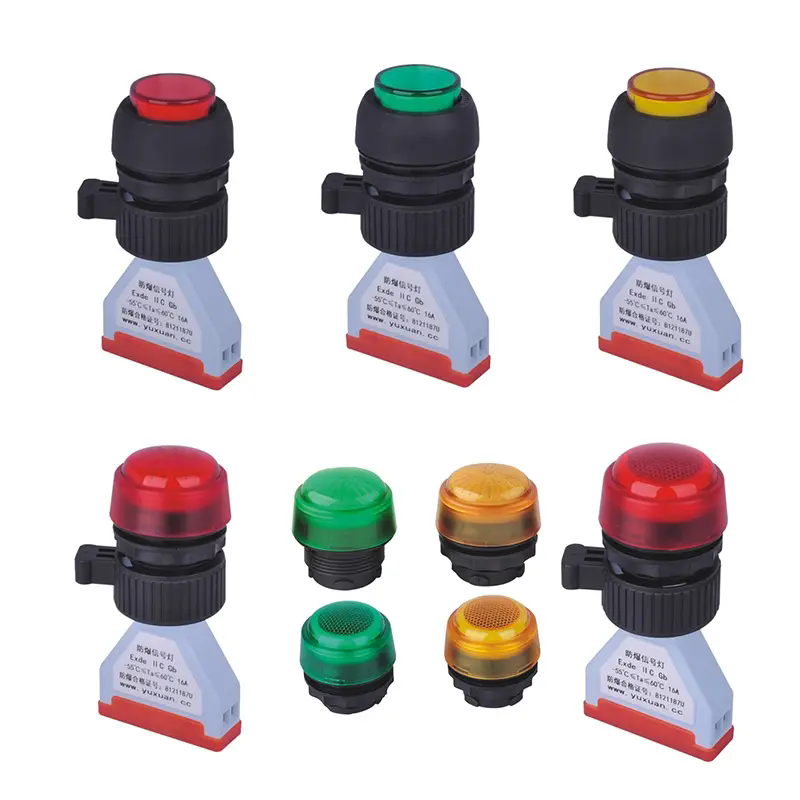How to Choose the Explosion Proof Signal Light for Industrial Safety
2025-09-01
In hazardous industrial environments, safety always comes first. One of the essential components that ensures workplace safety is an Explosion Proof Signal Light. Designed to operate reliably in locations with flammable gases, combustible dust, and other potentially explosive materials, these signal lights play a critical role in providing timely warnings and ensuring the safety of both personnel and equipment.
What Is an Explosion Proof Signal Light?
An explosion proof signal light is a specially designed industrial warning device built to withstand and prevent the ignition of hazardous gases, vapors, or dust in potentially explosive environments. Unlike traditional signal lights, these units are engineered with robust enclosures and flameproof structures, ensuring that any internal sparks or explosions remain contained within the housing without igniting the surrounding atmosphere.
Explosion proof signal lights are commonly used in:
-
Oil & gas facilities
-
Chemical processing plants
-
Offshore platforms
-
Mining operations
-
Power generation plants
-
Grain silos and food-processing factories
-
Pharmaceutical manufacturing environments
Why They Are Critical for Workplace Safety
In industrial environments, a simple spark can trigger catastrophic explosions if flammable substances are present. Explosion proof signal lights help mitigate this risk by:
-
Providing visual and audible alerts during emergencies or abnormal conditions.
-
Operating safely in locations with hazardous substances without causing ignition.
-
Ensuring regulatory compliance with strict industrial safety standards, such as ATEX, IECEx, and UL certifications.
How Explosion Proof Signal Lights Work
The working principle of an explosion proof signal light revolves around containing potential ignition sources within a sealed enclosure, preventing hazardous gases or dust outside from catching fire. Unlike intrinsically safe devices that limit electrical energy, explosion proof designs allow normal operation but provide a flameproof housing.
Key Features and Working Mechanisms
-
Flameproof Enclosure: The robust aluminum alloy or stainless steel housing contains any internal sparks or small explosions.
-
High-Grade Lens: Made from tempered glass or polycarbonate for excellent light transmission and impact resistance.
-
LED or Xenon Technology: Provides high-intensity illumination for signaling while minimizing energy consumption.
-
Ingress Protection (IP): Ensures the device is dust-tight and waterproof, typically rated IP66 or IP67.
-
Temperature Class Ratings: Specifies maximum surface temperature to avoid igniting surrounding substances.
Technical Specifications of Explosion Proof Signal Lights
When selecting an explosion proof signal light, technical specifications play a vital role in ensuring compatibility, reliability, and safety in your specific working environment. Below is an example of the specifications for YXFB Explosion Proof Signal Lights:
| Parameter | Specification |
|---|---|
| Material | Die-cast aluminum alloy / stainless steel |
| Lens Material | Tempered glass or polycarbonate |
| Light Source | High-brightness LED / Xenon |
| Power Supply | AC 110V / 220V / 380V or DC 12V / 24V |
| Operating Temperature | -40°C to +60°C |
| Ingress Protection | IP66 / IP67 |
| Explosion Protection | Ex d IIB T6 Gb / Ex d IIC T6 Gb |
| Color Options | Red, Green, Yellow, Blue, White |
| Mounting Options | Wall-mounted, pole-mounted, ceiling-mounted |
| Certifications | ATEX, IECEx, UL, CE |
These technical parameters ensure that the product is suitable for harsh environments where maximum safety is required.
How to Choose the Right Explosion Proof Signal Light
Selecting the ideal explosion proof signal light for your facility involves assessing both the environmental conditions and application requirements. Below are the critical factors to consider:
A. Understand Your Hazard Zone
Industrial facilities are classified into different hazardous zones based on the concentration of flammable gases or dust:
-
Zone 0 / Zone 20 → Continuous presence of explosive gases/dust.
-
Zone 1 / Zone 21 → Likely occurrence during normal operations.
-
Zone 2 / Zone 22 → Explosive substances are unlikely but possible.
Choosing a signal light with the correct explosion protection rating ensures compliance with safety regulations.
B. Select the Appropriate Light Source
-
LED: Energy-efficient, long lifespan, excellent brightness, ideal for continuous operation.
-
Xenon: Produces extremely bright flashing lights, ideal for emergency alarms.
C. Consider Visibility and Sound Output
Some explosion proof signal lights combine visual indicators with audible alarms. In noisy environments like oil refineries, combining flashing beacons with loud sirens ensures maximum awareness.
D. Ensure Proper Installation and Mounting
Incorrect installation may compromise safety. Always ensure:
-
Mounting location complies with safety zone classifications.
-
Proper grounding and cable sealing to avoid sparks.
-
Regular maintenance and inspection to ensure continuous protection.
Explosion Proof Signal Light FAQs
Q1: What certifications should I look for when buying an explosion proof signal light?
A1: Always choose products certified by recognized safety authorities such as ATEX, IECEx, or UL. These certifications guarantee that the device has undergone rigorous testing and meets international safety standards for explosive atmospheres.
Q2: How do I maintain an explosion proof signal light?
A2: Regular maintenance is critical to ensure continued safety. Follow these steps:
-
Inspect the enclosure for cracks or corrosion.
-
Check lens clarity and replace if fogged or damaged.
-
Verify electrical connections are secure and properly sealed.
-
Test the signal light periodically to ensure correct functionality.
YXFB is a trusted manufacturer specializing in high-quality explosion proof equipment. Our explosion proof signal lights are designed to deliver maximum safety, long-lasting performance, and regulatory compliance for hazardous environments worldwide.
With industry-leading certifications, robust materials, and cutting-edge LED technology, YXFB products are widely used in oil & gas facilities, offshore platforms, chemical plants, and more.
For tailored recommendations or to request a quotation for YXFB Explosion Proof Signal Lights, contact us today and let our team of experts help you select the perfect solution for your industrial safety needs.



